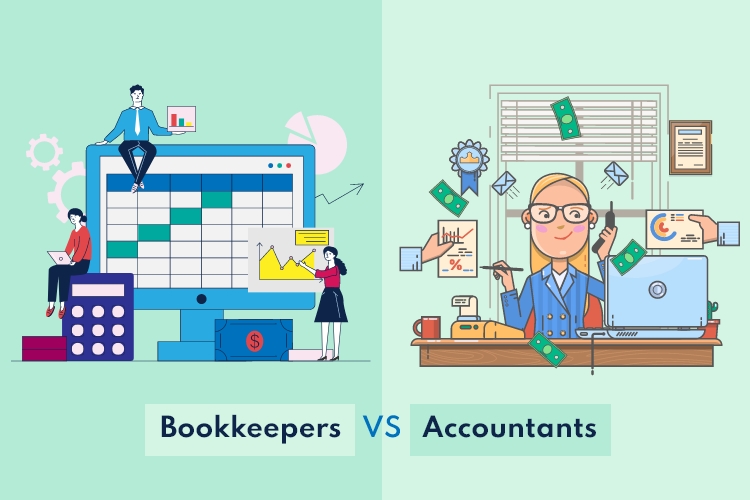You should hire a bookkeeper, accountant, or both if you don’t have the knowledge and skills to keep track of your company’s finances. Though a bookkeeper and an accountant both do number crunching, there is a distinction in the tasks they perform, and knowing the difference will benefit you in one way or another. While some businesses use either one or the other, others use both. The key distinctions between a bookkeeper and an accountant are, for the most part, the educational qualifications and abilities required for each role. The definitions of both job titles, as well as a broad explanation of each role, are provided here.
Bookkeepers
A bookkeeper is a person who keeps track of a company’s day-to-day financial activities, administers the chart of accounts, and prepares financial statements for a set period of time. An entry-level bookkeeper and a full-charge bookkeeper are the two types of bookkeepers. Full-charge bookkeepers have more responsibilities than entry-level bookkeepers, but they have fewer than an accountant. A bookkeeper’s preferred qualifications are typically an Associate degree in accounting or business administration, or similar business experience. A person employed for a bookkeeping position should also be familiar with bookkeeping and Generally Accepted Accounting Principles (GAAP) (GAAP).
As previously stated, a bookkeeper’s primary function is to record financial transactions for the company. The data can be entered on a weekly, biweekly, monthly, or as needed basis by the business owner.
The following are some of a bookkeeper’s primary responsibilities:
• Maintain the chart of accounts.
• Create and issue financial statements.
1. Income Statement.
This is a financial statement that shows how a company’s financial performance has changed over time. Financial success is measured by how the company generates revenue and expenses via both operational and non-operating operations.
2. The financial statement.
This is a financial statement that illustrates the assets, liabilities, and owners’ equity of a company at a specific point in time.
3. Cash Flow Statement.
For the period mentioned in the statement’s header, this statement reports the sources and uses of cash by operating activities, investment activities, financing activities, and certain other supplemental information.
• Manage accounts payable and receivable.
1. Pay company debt as it becomes due; and
2. Ensure that receivables are promptly collected.
A bookkeeper can also assist with other tasks. However, the overall job responsibilities of a bookkeeper will be determined by the bookkeeper’s skill set and the amount of faith the business owner is willing to place in the accountant.
Accountants
An accountant is a person who has been educated in all aspects of accounting, including bookkeeping, financial statement preparation, tax computations, auditing, and account analysis. Certified Public Accountant (CPA), Certified Management Accountant (CMA), and Certified Internal Auditor (CIA) are the most prevalent accounting designations (CIA). It’s worth noting that Certified Internal Auditors and Certified Management Accountants don’t need to be licensed in order to work. Accountants must follow the Generally Accepted Accounting Principles (GAAP) rules and adhere to the ethical standards and guiding principles of the region in which they practice.
The entry level educational requirement for an accountant is a bachelor’s degree. In some situations, a master’s degree might be required. The preferred field of study is accounting, and for some positions, the CPA licensing credential is required.
Some principal responsibilities of an accountant are as follows;
• Analyze various accounting records.
Part of the person’s job will be to assess various accounting records, depending on the field of accounting in which he or she works. Accountants who work in accounts payable may spend a significant amount of time examining money spent on outside services and goods. After examining this data, upper management may be approached with proposals to help the organization minimize expenditures (reduce outgoing dollars). An accounts receivables accountant may spend a significant amount of time comparing different cash, cheque, and credit card receipts to the A/R balance.
• Tax Computations.
Accountants that compute taxes for businesses (Tax Accountants) concentrate on the company’s tax issues and normally record all assets, such as sales, before subtracting all liabilities, such as general expenses, salaries, office rent, and office supplies. The difference between assets and liabilities is referred to as net income.
• Budget Development.
Some accountants are in charge of creating the company’s budgets. However, input from numerous areas inside the organization is essential before generating budgets. Typically, department heads will compute their own budget before sending it to the accountant. The accountant can identify where cuts in the company need to be made based on the budgets from various departments in order for the company to meet its financial goals.
• Manage Employees.
The accountant’s employment generally entails hiring and training bookkeepers and accounting clerks. Certain portions of the accountant’s job are generally delegated to the bookkeepers and accounting clerks. Job responsibilities for each role can range from few to many, depending on the type of bookkeeper (entry level or full-charge), or the type of accountant.
Finally, unless the accountant is willing to handle the daily tedious work of entering data, updating the chart of accounts, or acting as a debt collector (which most accountants dislike), engage both a bookkeeper and an accountant if your business can afford it. In a nutshell, accountants are trained to manage all aspects of accounting, whereas bookkeepers record and classify financial transactions, laying the framework for accountants to analyze financial data.


